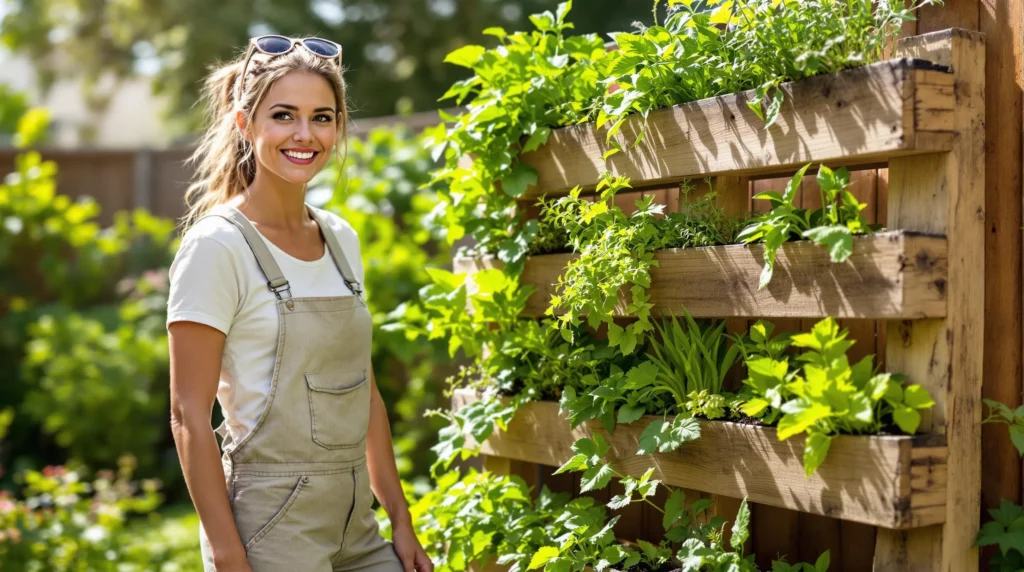Why Pallet Gardens Are Perfect for Growing Vegetables
- Space-saving solution: Pallet gardens allow you to grow vegetables vertically, making them ideal for small spaces like balconies, patios, or limited yard areas.
- Built-in organization: The slats in pallets create natural rows for planting, keeping your vegetables neatly separated and easy to identify.
- Reduced weeding: The structure of pallets minimizes areas where weeds can grow, saving you time on garden maintenance.
- Better pest control: Elevated planting makes it easier to spot and manage pests that might damage your vegetables.
- Improved drainage: The gaps between pallet boards provide excellent drainage for vegetable plants, preventing root rot.
- Cost-effective gardening: Pallets are often free from recycling centers or local businesses, making this an economical way to start a vegetable garden.
- Easier harvesting: Growing vegetables in a pallet garden keeps them at a comfortable height, reducing strain on your back during harvesting.
- Natural plant separation: Different vegetable varieties stay contained in their designated spaces, preventing aggressive plants from overtaking others.
- Cleaner produce: Elevated growing keeps vegetables like strawberries and leafy greens off the ground, resulting in cleaner produce.
- DIY versatility: You can customize your pallet garden by staining it, adding wheels for mobility, or mounting it on a wall to suit your space.
Choosing the Right Pallets for Your Vegetable Garden
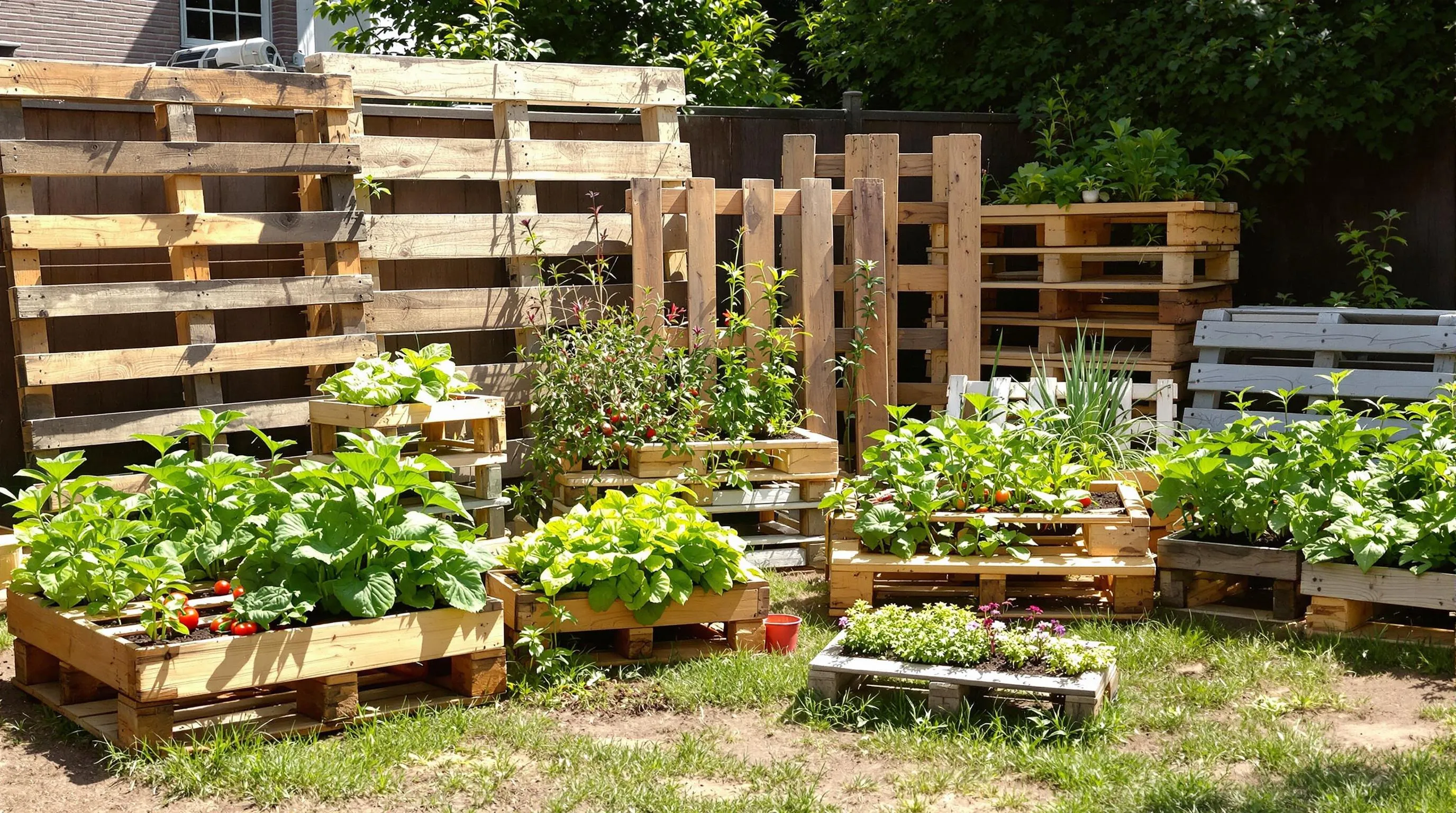
Selecting appropriate pallets is crucial for creating a safe and durable vegetable garden. The right choices will protect your plants and ensure your homegrown vegetables are free from harmful chemicals.
How to Identify Safe Pallets for Gardening
Look for pallets with exact markings to ensure they’re safe for growing edibles:
- Check for treatment stamps: Safe pallets will be marked with “HT” (heat-treated), “DB” (debarked), or “KD” (kiln-dried) stamps, indicating they haven’t been chemically treated.
- Avoid chemical treatments: Never use pallets treated with pesticides or other chemicals for vegetable gardens, as these substances can leach into your soil and contaminate your food.
- Inspect for damage: Examine pallets for signs of rot, decay, splinters, or chemical stains that could indicate previous exposure to hazardous materials.
- Look for the IPPC logo: Pallets with the International Plant Protection Convention logo have been heat-treated rather than chemically treated, making them safer for gardening.
- Consider the history: Try to learn about the pallet’s previous use. Avoid those that may have transported fuel, pesticides, or other toxic materials.
- Clean thoroughly: Before planting, scrub your pallet with soapy water and allow it to dry completely to remove any residual dirt or contaminants.
Best Pallet Types for Vegetable Growing
Different pallet varieties offer unique advantages for vegetable gardening:
- Standard pallets: The most common size (48″×40″×6″) provides ample planting space and stability for various vegetables.
- Hardwood pallets: Made from oak or maple, these offer superior durability and resistance to decay compared to softwood options.
- Euro pallets: Smaller in size, making them ideal for compact spaces like balconies or small patios.
- Mini pallets: Perfect for creating portable herb gardens or growing small vegetables in limited spaces.
- Block pallets: These have blocks instead of stringers between the deck boards, providing better airflow for your plants’ root systems.
- Untreated wood pallets: The safest option for growing edibles, ensuring no harmful chemicals will contaminate your vegetables.
Remember that pallet gardens work best for vegetables with shallow root systems, such as peppers, peas, beans, cucumbers, strawberries, lettuce, and herbs.
10 Creative Pallet Garden Ideas for Vegetables
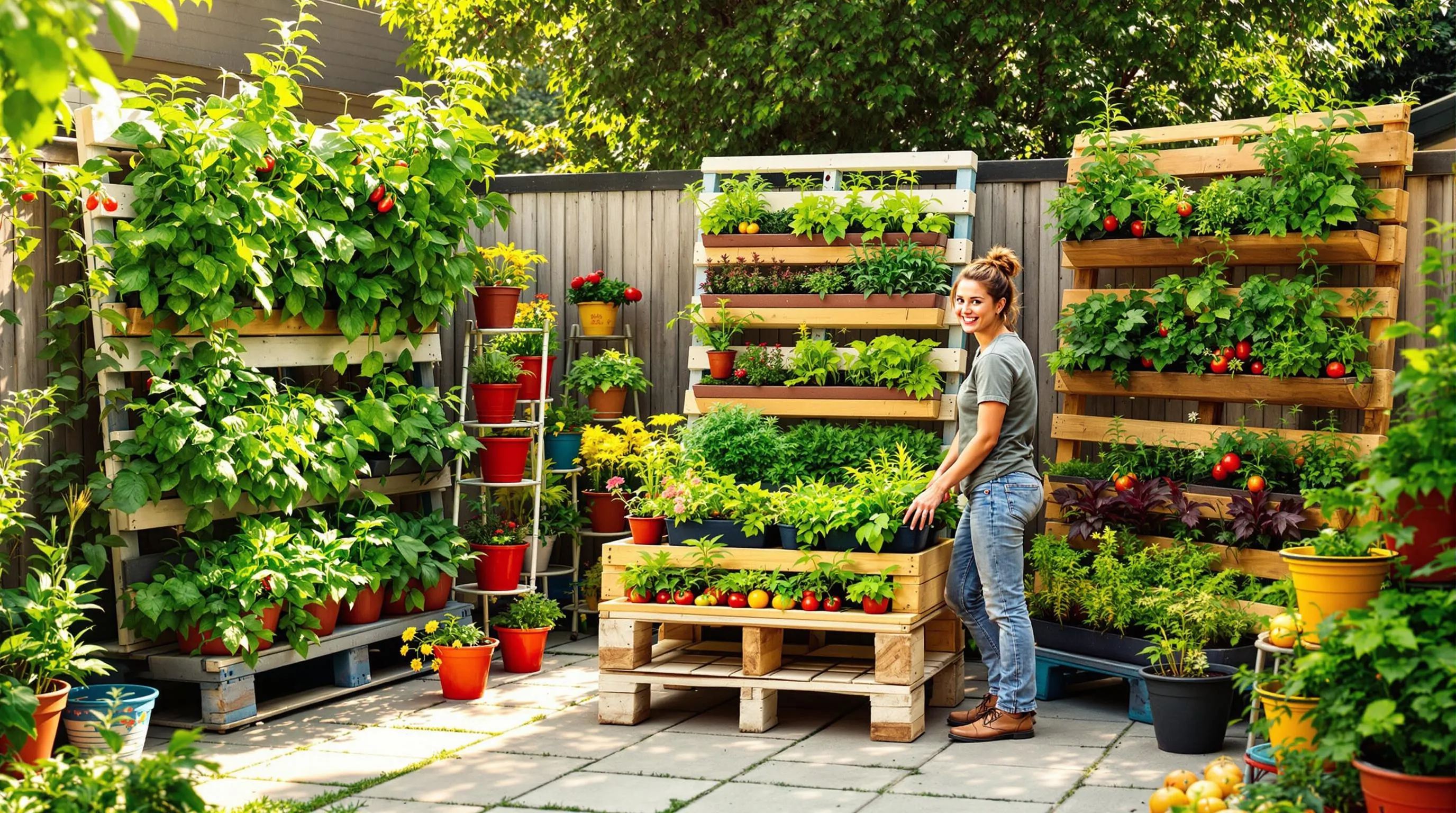
Transform unused wooden pallets into productive vegetable gardens with these innovative ideas. Each design maximizes growing space while using sustainable materials that are often available for free.
Vertical Pallet Vegetable Gardens
Create a space-saving vertical garden by mounting a pallet against a wall or fence. Install flowerpot rings, hooks, or shelves onto the pallet frame to hold various vegetables in pots. For stability, bury the base a few inches into the ground if using it as a free-standing structure. Line the back with industry fabric to retain soil and moisture. This vertical approach works exceptionally well for leafy greens, herbs, and compact vegetables like cherry tomatoes.
Horizontal Pallet Raised Beds
Transform pallets into efficient raised beds by laying them flat and filling with soil. This design provides deeper soil depth for vegetables with larger root systems. Simply prepare by adding quality potting soil, allowing it to settle, and planting directly on the pallet’s surface. The slats naturally divide growing areas, reducing weeding and keeping plants organized. Root vegetables like carrots, radishes, and beets thrive in these beds, along with larger plants like full-sized tomatoes and peppers.
Tiered Pallet Planters for Small Spaces
Maximize limited garden space by creating multi-level growing environments with tiered pallet planters. Remove and repurpose slats from pallets to build multiple small planter boxes arranged in tiers. This configuration creates an attractive stepped garden that’s perfect for patios or balconies. The tiered design allows for easy irrigation as water naturally flows from upper to lower levels. Plant compact vegetables like lettuce, spinach, and bush beans in these space-efficient structures.
Pallet Trellis Systems for Climbing Vegetables
Convert pallets into sturdy trellises by standing them upright and adapting their framework to support climbing plants. Add chicken wire or garden fencing to create more climbing surface area. These trellis systems are ideal for vining vegetables like pole beans, cucumbers, peas, and small squash varieties. The vertical growing direction optimizes garden space and allows you to plant shade-tolerant crops underneath, creating a multi-level growing environment.
Mobile Pallet Gardens on Wheels
Add mobility to your vegetable garden by attaching wheels to pallet planters. This practical modification allows you to rotate crops for optimal sunlight exposure or move them to protected areas during harsh weather. Simply secure sturdy casters to the bottom of a horizontal pallet planter, ensuring they can support the weight when filled with soil and plants. These rolling gardens are perfect for urban settings with changing light conditions and work well for growing herbs, lettuce, and other vegetables that benefit from being able to follow the sun.
Best Vegetables to Grow in Pallet Gardens
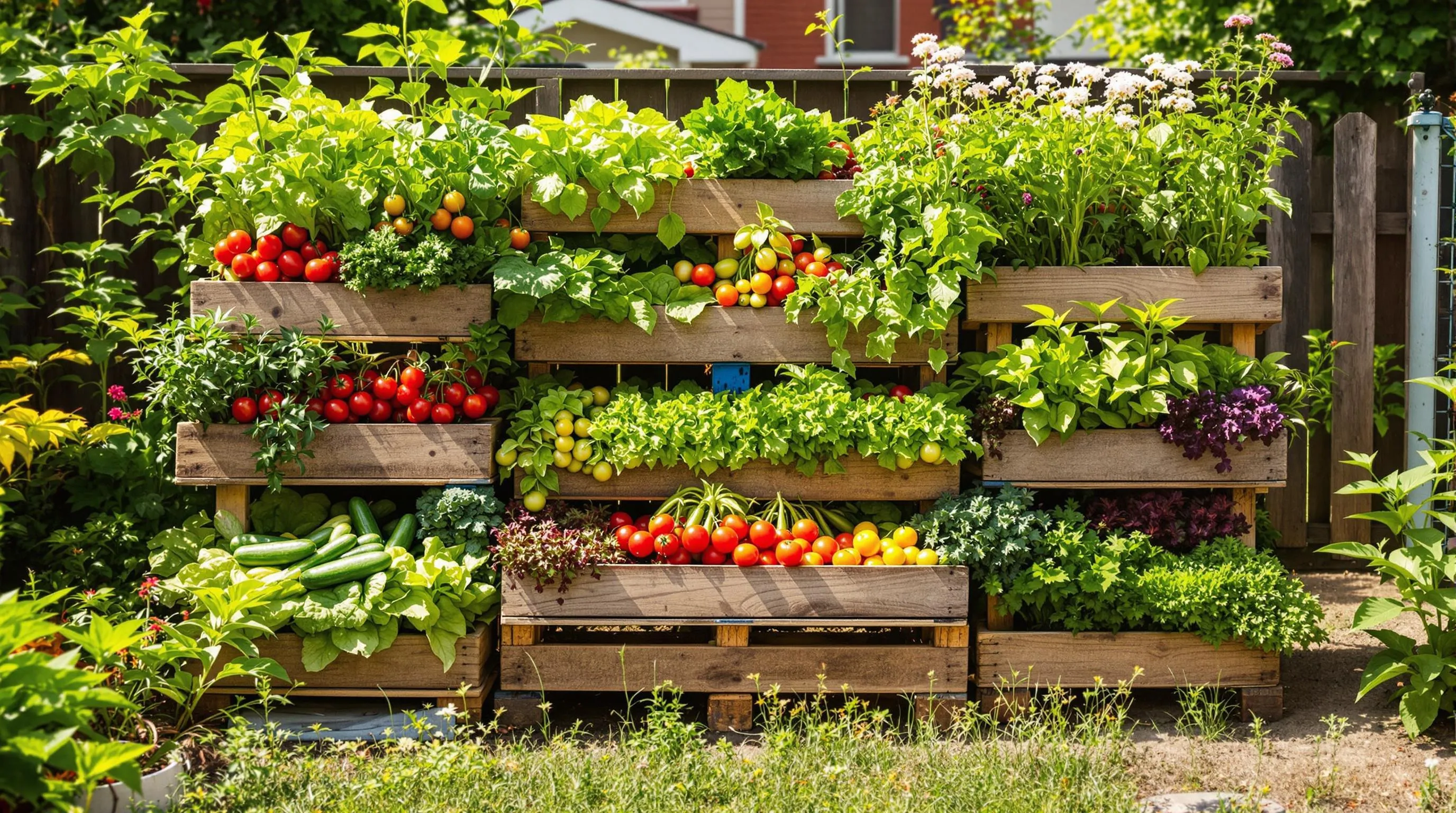
Pallet gardens offer an excellent solution for growing vegetables in limited spaces. With their versatile design, they can accommodate various types of vegetables depending on how you configure your garden.
Climbing Vegetables for Vertical Pallets
- Tomatoes thrive in vertical pallet gardens, particularly indeterminate varieties that benefit from trellises or cages for support as they grow upward.
- Cucumbers excel in pallet gardens with their natural climbing ability, making efficient use of vertical space when provided with sturdy trellises.
- Peas are perfect vertical growers that naturally climb and attach to supports, maximizing your pallet garden’s productivity.
- Beans, especially pole and runner varieties, grow excellently in vertical pallet setups, producing abundant harvests while taking up minimal space.
Shallow-Root Vegetables for Vertical Pallets
- Lettuce and other salad greens like kale and arugula flourish in the shallow spaces between pallet slats, making them ideal for vertical configurations.
- Radishes develop quickly in the limited soil depth of vertical pallets, providing fast harvests in tight spaces.
- Spinach grows well in the partial shade often created by vertical pallet structures, producing nutritious leaves throughout the growing season.
- Green onions require minimal soil depth and can be planted densely in vertical pallet gardens for continuous harvesting.
Leafy Greens for Horizontal Pallets
- Loose-leaf lettuce varieties are ideal for horizontal pallet gardens, providing multiple harvests from a single planting.
- Kohlrabi grows well in the organized sections of horizontal pallets, developing bulbs just above the soil surface.
- Mustard greens thrive in horizontal pallet configurations, adding spicy flavor to your garden with their shallow root systems.
- Beet greens offer dual benefits in horizontal pallets, providing nutritious leaves while developing roots in the shallow soil.
Herbs That Thrive in Pallet Gardens
- Thyme flourishes in the well-drained conditions pallet gardens naturally provide, spreading beautifully between slats.
- Parsley grows exceptionally well in pallet gardens, with its shallow roots perfectly suited to limited soil depth.
- Oregano thrives in the sunny conditions of pallet gardens, requiring minimal soil while producing abundant flavorful leaves.
- Chives are perfect for pallet gardens with their compact growth habit and minimal root spread.
- Mint adapts well to pallet gardening, though it’s best planted in isolated sections to prevent it from overtaking other herbs.
- Dill grows quickly in pallet gardens, providing feathery foliage for culinary use throughout the growing season.
Step-by-Step Guide to Building a Pallet Vegetable Garden
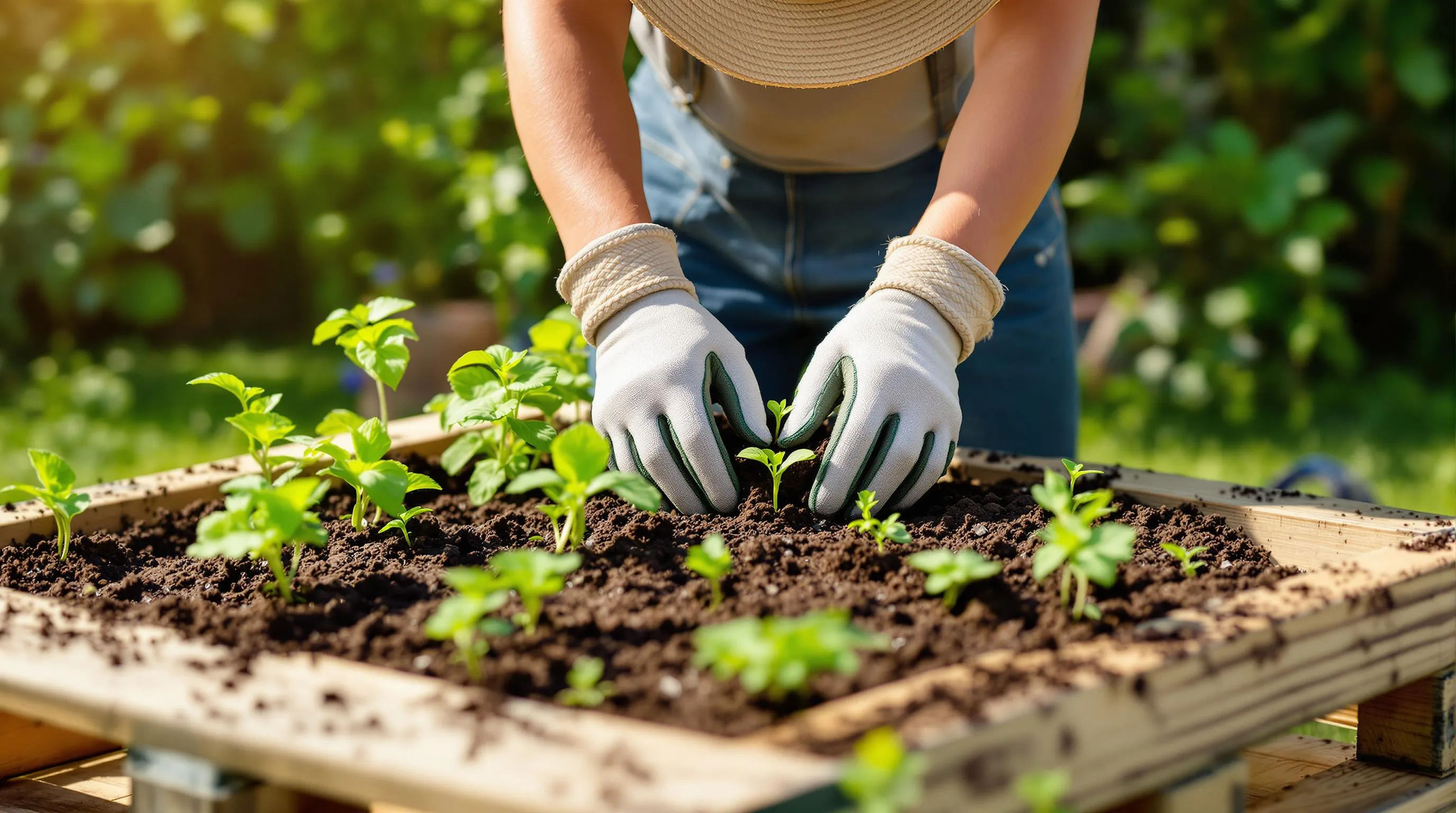
Transform an ordinary wooden pallet into a thriving vegetable garden with this easy-to-follow guide. Building your own pallet vegetable garden is both economical and rewarding.
Materials and Tools Needed
- Pallet: Choose a wooden pallet in good condition without rot or damage. Look for heat-treated (HT) pallets for vegetable gardening safety.
- Soil: Quality potting mix or garden soil that retains moisture while providing good drainage.
- Industry Fabric: Essential for preventing soil from falling through and deterring weeds.
- Staple Gun & Staples: For securing the industry fabric to the pallet structure.
- Scissors/Utility Knife: To cut and trim the industry fabric as needed.
- Gardening Gloves: Protect your hands during assembly and planting.
- Seeds or Seedlings: Select vegetables appropriate for pallet gardening (shallow-rooted varieties work best).
- Water Source: Garden hose, watering can, or irrigation system for ongoing plant care.
Assembly Instructions
- Prepare the Pallet: Sand any rough edges to prevent splinters and clean the pallet thoroughly with soapy water. Allow it to dry completely before proceeding.
- Add Industry Fabric: Cut pieces of industry fabric large enough to cover the back and bottom of the pallet. Staple the fabric securely, creating a barrier that contains soil while allowing drainage.
- Fill with Soil: Position your pallet horizontally and fill the open slats about ¾ full with your prepared soil mixture. Press the soil down gently to eliminate air pockets.
- Plant Vegetables: Plant your seeds or seedlings in the soil-filled slats. Space plants according to their exact needs, considering how they’ll grow within the pallet’s structure.
- Set Up: Place your completed pallet garden in a location that receives adequate sunlight for the vegetables you’ve chosen to grow. Ensure the pallet sits flat and stable.
Soil and Irrigation Tips
- Soil Choice: Use a mix of compost and potting soil for optimal nutrition. The ideal mix retains moisture while draining well to prevent root rot.
- Soil Depth: Ensure adequate soil depth for your chosen vegetables—most garden vegetables need at least 6-8 inches for proper root development.
- Watering Frequency: Water daily during hot weather, adjusting based on rainfall and temperature. Morning watering helps prevent fungal issues.
- Drainage: Check that excess water can drain properly through the industry fabric to prevent waterlogging.
- Maintenance: Top up soil as needed throughout the growing season as it may compact or wash away with regular watering.
- Fertilizing: Apply liquid fertilizer every 2-3 weeks to maintain nutrient levels in the limited soil volume.
Maintaining Your Pallet Vegetable Garden
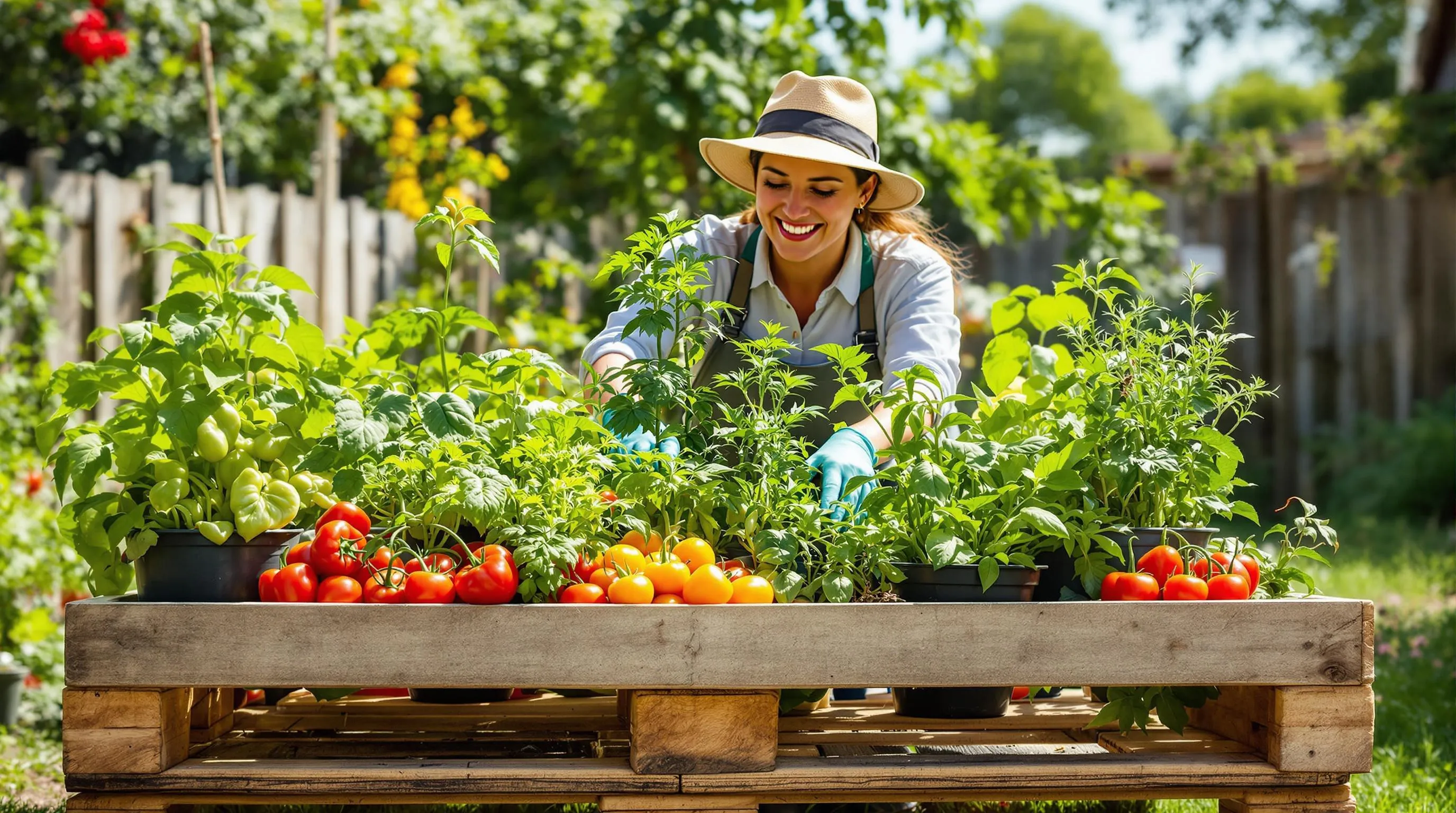
Proper maintenance is essential for keeping your pallet vegetable garden thriving throughout the growing season. With the right care routine, you’ll enjoy a bountiful harvest and extend the life of your garden.
Seasonal Care Requirements
Spring and summer require consistent watering and nutrient supply for optimal vegetable growth in your pallet garden. Pack good-quality potting soil tightly into the pallet spaces to support strong root development and water thoroughly to settle the soil without causing waterlogging that could promote rot. During hot summer days, check soil moisture levels daily as pallet gardens can dry out quickly due to their exposed nature.
In cooler months, consider moving portable pallet gardens indoors or protecting them with covers to prevent frost damage. Remove dead or diseased leaves regularly to prevent fungal growth and improve airflow between plants. This simple maintenance task significantly reduces the risk of disease spreading throughout your vertical garden.
For year-round care, monitor soil moisture levels consistently since pallet gardens can dry out faster than traditional beds. Apply organic fertilizer every 4-6 weeks during the growing season to replenish nutrients that may leach out with frequent watering.
Pest Management Answers
Regularly inspect your pallet vegetable garden for pests, focusing particularly under leaves and along stems where insects often hide. Early morning or evening are the best times for inspection as many pests are more active during these periods.
Use these organic pest control methods for your pallet garden:
- Remove pests manually or spray with water to scatter smaller insects like aphids
- Clear debris and dead plant material around the pallet garden to eliminate pest hiding spots
- Maintain healthy plants through proper fertilization and watering to boost their natural pest resistance
- Introduce beneficial insects like ladybugs to control aphid populations naturally
- Apply neem oil spray to combat a variety of common garden pests without harmful chemicals
- Place sticky traps between plants to catch flying insects before they can damage your vegetables
- Create physical barriers with row covers for sensitive seedlings and young plants
For preventative care, ensure proper spacing between plants to improve air circulation and reduce conditions that attract pests and disease. Remember that healthy plants in well-maintained pallet gardens naturally resist pest infestations better than stressed or undernourished plants.
Harvesting Tips for Pallet-Grown Vegetables
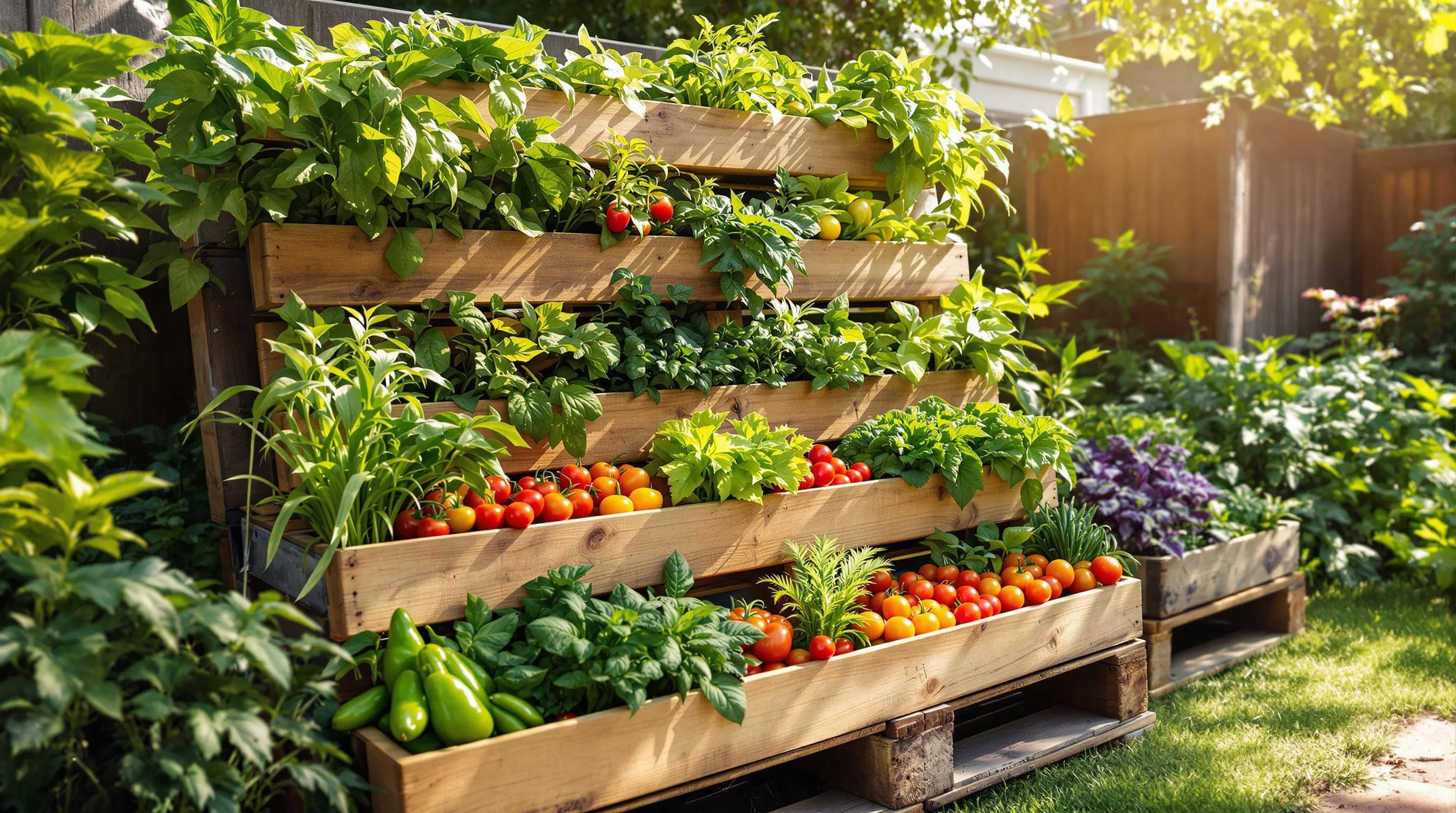
Timing Your Harvest
Harvesting vegetables from your pallet garden at the right time ensures optimal flavor and nutritional content. Pick leafy greens in the early morning when they’re crisp and flavorful. Harvest peppers and tomatoes when they’ve reached their full color for maximum ripeness. Monitor your plants daily, especially during peak growing seasons, as vegetables in pallet gardens often mature faster due to the controlled growing environment.
Proper Harvesting Techniques
Use the right techniques to harvest your pallet-grown vegetables without damaging the plants. Cut leafy greens like lettuce and spinach with scissors rather than pulling them to encourage regrowth. Harvest climbing vegetables such as peas and beans by gently pinching the stems. For peppers and tomatoes, twist gently or use pruning shears to avoid disturbing neighboring plants in your vertical setup.
Watering Before Harvest
Water your pallet garden slowly and consistently before harvesting to ensure root stability and prevent soil displacement. This is especially important in vertical pallet systems where soil can easily dry out. A thorough watering 24 hours before harvest helps plants recover from any stress and ensures vegetables are well-hydrated and crisp when picked.
Managing Your Vertical Harvest
Harvesting from vertical pallet gardens requires special attention to maintain their stability. Start harvesting from the bottom sections first to maintain the garden’s balance. Regular harvesting of leafy greens and small fruits like peppers and strawberries encourages continued production throughout the growing season. Monitor plants closely since pallet environments dry out faster than traditional beds.
Post-Harvest Care
After harvesting, apply liquid fertilizers to promote healthy growth in the limited soil volume of your pallet garden. Replenish any soil that may have been displaced during harvesting. Remove any plant debris to prevent disease and pest issues. For continuous harvests, consider succession planting in empty spaces where you’ve already harvested vegetables.
Extending Your Harvest Season
Maximize your pallet garden’s productivity by planning for continuous harvests. Plant fast-growing vegetables like lettuce and radishes between slower-growing crops. Use row covers or plastic sheeting to protect your pallet garden from early frosts, extending your growing season into cooler months. This approach is particularly effective for vertical pallet gardens that can be easily covered or moved if needed.
Common Challenges and Solutions for Pallet Gardens
Your pallet garden journey doesn’t need to end with the first harvest. As you develop your green thumb you’ll face challenges worth overcoming. Watch for uneven watering in vertical setups and install a drip system for consistent moisture. If your pallet garden feels unstable add cross braces or anchor it to a wall for safety.
Limited soil depth might restrict some vegetable choices but you’ll find plenty of shallow-rooted options that thrive. Remember that wood eventually deteriorates so apply non-toxic sealants to extend your garden’s lifespan. With these answers in mind your pallet vegetable garden will continue producing bountiful harvests while adding sustainable charm to your space.
Start small experiment often and watch your pallet garden grow into a productive food source you’ll be proud to show off.

